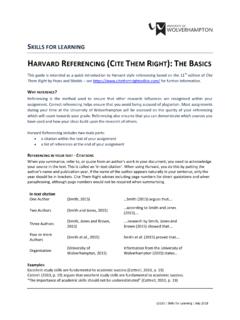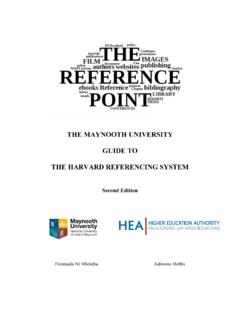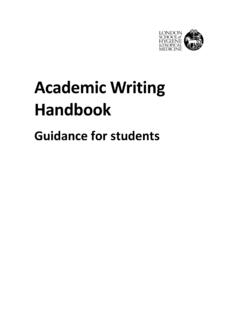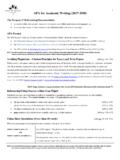Transcription of The University of South Wales Guide to Harvard Referencing
1 The University of South Wales Guide toHarvard Referencing Revised Edition May 2021 This document is available in Welsh. Mae r ddogfen hon ar gael yn to Harvard referencingReferencing2 Short quotation3 Long quotation4 Secondary referencing4 Referencing author with more than one publication in the same year4 Books5 Journals7 Newspapers8 The Internet9 Conferences/theses/public lectures11 Other sources12 Visual sources16 Audio-visual material17 Live performances20 Computer games21 Computer programmes21 Personal communication22 ContentsNext u1 ReferencingWhat is Referencing ? Referencing is indicating in assignments when you have used material that has not originated with you. This might include factual information, data, images, opinion, direct quotation, or when you summarise or paraphrase the work of other people.
2 Why reference ?The majority of academic assignments measure your ability to understand, analyse and evaluate the work of others. Consequently, Referencing is a crucial part of this as it informs the reader of the texts you have consulted during research; you will also be assessed on the quality and relevancy of these sources. It is important to remember that Referencing carries a percentage of the overall marks if undertaken appropriately. Plagiarism academic integrityPlease see this page for more information about plagiarism and good academic practice: to referenceThere are a number of different Referencing styles, all of which are equally valid. Always check with your lecturer if you are unsure which style you should be example on page 3 shows how to reference (cite) using the Harvard style of Referencing .
3 This is one of the most widely used systems based on the British Standard BS5605 (1990). The basic requirements for incorporating references into your work are to supply the family name of the author (or authoring body) and the year of publication in sentences and paragraphs. Where in your text you do this is the first component of the Referencing system (in-text Referencing ). The second component is the full details of all references you have used given in a list at the end of your assignment. Both components have to be included in any submitted piece of work. How to use this Guide This Guide highlights some of the sources that can be referred to when writing an assignment. The various Referencing requirements for each source are presented and include an in-text and reference list example.
4 However, the Guide does not include all possible sourcesthat you might encounter during the course of your studies. Please seek advice from your lecturer, the Study Skills Service, or your Faculty Advice Centre if you need guidance that does not feature here. There are several ways of including sources in your work. You can summarise, paraphrase or directly quote the information. You may also wish to secondary reference and/or refer to an author with more than one publication in a single year. Whichever you use, you let your reader know by setting out the Referencing details in a subtly different way as below. Please note that the Guide presents information in columns. References in text or in a list should be written across the full page when writing your you are summarising the overall argument or position of a book or article then you only need to insert the author s name and year of publication, you do not need to put page numbers in the text or in the reference list.
5 ParaphrasingIf you are paraphrasing a specific point from your source you should include page numbers in the text, as well as the author s name and year. This makes it easier for your reader to find the information being referred uttReturn to contentstPreviousAn example of a referenced paragraph and Referencing listreferencing/quoting3 Student Development and Study Skills 2015. Adapted from:Leeds Metropolitan University (2009) Quote, unquote: A Guide to Harvard Referencing , p. 6. Available at: http:// (Accessed: 11 July 2010).In-text example:Chartrand, Millar and Wiltshire (1997, ) argue that ..they [laws] can be said to be just when they create the conditions leading to peace, happiness and prosperity for all persons.
6 This view example:Chartrand, M., Millar, C. and Wiltshire, E. (1997) English for contract and company law. London: Sweet and Maxwell. Note Short quotations, up to two or three lines should be putin double quotation marks and included in the body ofthe quotation Next uttReturn to contentstPreviousIn-text example:Most false-belief tests use children with a mental age of 3-4 years but all those children with autism tested had amental age higher than this (Baron-Cohen, 1989a). In afurther experiment (Baron-Cohen, 1989b) children withautism were asked what they thought the brain was example:Baron-Cohen, S. (1989a) The autistic child s theory of mind: A case of specific developmental delay , Journal of Child Psychology and Psychiatry, 30, pp.
7 285-298. Baron-Cohen, S. (1989b) Are autistic children behaviourists? An examination of their mental-physical and appearance-reality distinctions , Journal of Autism and Developmental Disorders, 19, pp. 579-600. Note If you need to cite two (or more) publications by anauthor published in the same year, you will need todistinguish between them in the text and in the reference list. You do this by allocating lower case letters in alphabetical order after the publication with more than one publication in the same yearIn-text example:McMahon s (1994) experience as cited in Parahoo (2006, p. 246) draws attention to the dilemma surrounding theissue of persuasion when attempting to example:Parahoo, K.
8 (2006) Nursing research: principles, process and issues. 2nd edn. Basingstoke: Palgrave Sometimes authors refer to the work/ideas of are known as secondary references. For instance,Parahoo in 2006 makes reference to McMahon sexperience in 1994. The details of Parahoo s work shouldbe included in the reference list since this is the work youhave read. (It is not advisable to use too many of these).Secondary Referencing quoting4In-text example:Most people are biased in one way or another. Person bias, sometimes called the fundamental attribution error, is claimed to be the most common. So we see a nurse, or a teacher or a policeman or policewoman going about their business and tend to judge them as being particular types of people rather than as people being constrained by the roles that they are playing in their work (Strongman, 2006, p.)
9 94). reference example:Strongman, K. T. (2006) Applying psychology toeveryday life: a beginner s : John Wileyand Sons Longer quotations should be indented from the main textas a separate paragraph. Quotation marks are quotation Next uttReturn to contentstPreviousbooks5In-text example:Thompson (2003) suggests that language helps to form identity, but can create stereotypes and example:Thompson, N. (2003) Communication and language: A handbook of theory and practice. Basingstoke: Palgrave /editor (surname or family name before initials)2. Year of publication (in round brackets)3. Title (in italics)4. Edition (only include the edition number if it is notthe first edition)5.
10 Place of publication: Publisher6. Series and volume number (where relevant)Book with single author In-text example:This was indicated in the study by Huxley et al.(2007). reference example:Huxley, P., Evans, S., Muroe, M. and Cestari, L. (2007) Fairaccess to care services in integrated mental health andsocial care : Department of (s) / editor(s) (surname or family namebefore initials)2. Year of publication (in round brackets)3. Title (in italics)4. Edition (only include the edition number if it is notthe first edition)5. Place of publication: Publisher6. Series and volume number (where relevant)Book with more than three authors In-text example:According to Dexter and Wash (1995, pp.)





